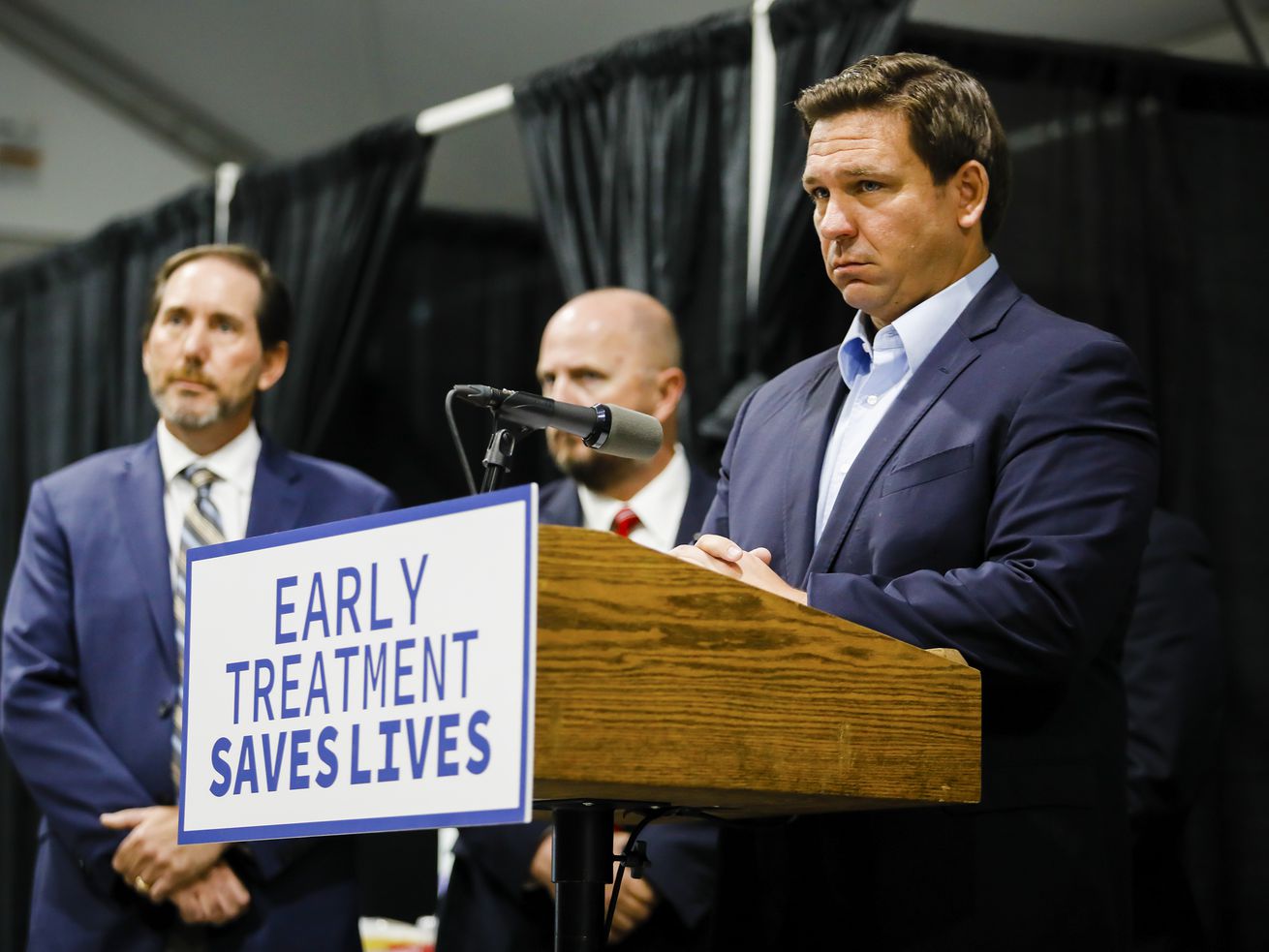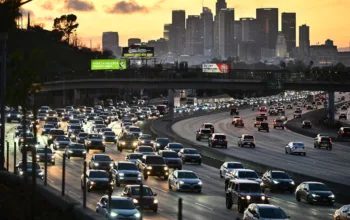The Florida surge is a microcosm of a summer gone wrong.
It’s no mystery what’s happening in Florida right now — or why.
The state is experiencing its worst surge of the pandemic. Last week, it was averaging nearly 25,000 new cases every day. The previous high, in January, was about 18,000. More than 17,000 Floridians are hospitalized with Covid-19, another record; around 230 people are dying every day. Florida leads all states in the number of hospitalizations and deaths per capita.
The city of Orlando has urged residents to limit their water use, because the same liquid oxygen used to treat the water supply is being used to provide air to Covid-19 patients. The Florida health department asked the federal government to send more ventilators as the number of hospitalized patients spiked — a request Gov. Ron DeSantis, who has staked his political reputation on his laissez-faire response to the pandemic, claimed to know nothing about.
In recent days, cases may have started to plateau, increasing “only” 11 percent in the last two weeks. But it’s hard to be sure because testing is inadequate: nearly 20 percent of tests are coming back positive in the state. Experts say that number should be at 5 percent or lower in order to be confident most cases are being caught.
/cdn.vox-cdn.com/uploads/chorus_asset/file/22803540/AP20323775851327_copy.jpg) Lynne Sladky/AP
Lynne Sladky/APFor most of last year, Florida looked like a success story for the people who advocated for a less restrictive response to Covid-19. Its case and death rates weren’t noticeably worse than other states that were more aggressive about mandating masks or closing businesses.
So why is Florida is experiencing its worst surge now, 18 months into the pandemic, when the vaccines are widely available?
In some ways, what’s happening in Florida right now is a microcosm of the current surge across America: a middling vaccination rate has collided with a more contagious version of the virus. And it’s doing so in a state where political leaders continue to insist people should act as if the pandemic is over — even as more people are dying every day than any point in the past year.
Florida is overwhelmed with new Covid-19 cases and hospitalizations
About half of Florida residents, 52 percent, are fully vaccinated, according to the Times’s data. That’s not terrible — Mississippi and Alabama currently rank last, with less than 38 percent — but it’s not great either. The Sunshine State is 25th among states in vaccination rate.
Florida is not a monolith; some communities have much higher levels of protection than others. Case levels trend accordingly, with the less vaccinated areas seeing more spread. In counties with more than 1,000 new cases per 100,000 people, vaccination rates are stuck in the 30s and 40s.
Counties with vaccination rates of 60 percent or above are still seeing a good amount of spread. But it’s substantially less, sometimes by more than half, than the worst-off areas, according to the state’s data. Less vaccinated counties have been driving the current wave.
“Insufficient vaccine coverage is contributing a lot,” Cindy Prins, a University of Florida epidemiologist, told me.
/cdn.vox-cdn.com/uploads/chorus_asset/file/22803546/GettyImages_1234719903_copy.jpg) Chandan Khanna/AFP via Getty Images
Chandan Khanna/AFP via Getty ImagesThe now-dominant delta variant has also made the situation worse because it spreads more efficiently than the previous iterations. It also seems to cause more virulent disease, which is likely contributing to the record number of hospitalizations.
Different age groups also have different degrees of protection against the delta variant. Nearly nine in 10 Floridians over the age of 65 are vaccinated, giving a high level of protection to the people most vulnerable to getting severely ill from Covid-19.
But less than 60 percent of people ages 30 to 39 are vaccinated, as are less than 50 percent of those aged 12 to 29, according to state data. Large numbers of young people in Florida are fully vulnerable to the delta variant, and some of them are getting very sick. One hospital system serving central Florida reported last week that half of its patients currently hospitalized with Covid-19 are under 40.
Hospitals are feeling the strain of the current surge. Just 7 percent of the state’s ICU beds are currently available, according to the Florida Hospital Association, and more than half of the people currently in ICUs statewide have Covid-19.
“Several hospitals have had to procure and request more [ventilators], and oxygen deliveries continue to be a challenge,” Savannah Kelly, an FHA spokesperson, said in an email.
Gov. Ron DeSantis’s pandemic strategy is being put to the test
DeSantis, who has clear presidential aspirations in 2024, has positioned himself and his state’s Covid-19 response against the public health establishment throughout the pandemic and, more recently, the Biden administration.
Though he, like most governors, closed many businesses last spring, they were allowed to reopen in May of 2020; DeSantis steadfastly refused to consider any new closures during following waves in the summer and winter. He ended the state’s mask mandates on May 4, 2021, before the CDC changed its own masking guidance, and he has resisted calls to reimpose them even as cases surged again.
The governor tried to block local school districts from setting their own mask mandates for the new school year and threatened to withhold the salaries of any officials who implement a masking policy. Some school districts are pushing ahead anyway. He also has opposed businesses requiring vaccines for their employees or customers.
/cdn.vox-cdn.com/uploads/chorus_asset/file/22803554/GettyImages_1294927045_copy.jpg) Joe Raedle/Getty Images
Joe Raedle/Getty ImagesExperts said the state’s policies, which have signaled to the vaccinated and unvaccinated alike that it’s okay to go about their normal lives, are making it easier for the virus to spread.
“There are still a large absolute number of unvaccinated people, relatively few people practicing social distancing or masking, by choice and also due to the absence of policies requiring them,” Joshua Michaud, associate director for global health policy at the Kaiser Family Foundation, told me. “Schools and universities going back into session, and lots of delta introductions in the state all happening at the same time.”
The situation has led to a sort of theater of the absurd, with DeSantis fighting local mitigation measures while at the same time promoting new treatments for people who get so sick they need to be hospitalized because of Covid-19.
Florida’s pandemic failures are a microcosm of America’s struggles
Florida, like much of America, was betting the pandemic was behind it — and was wrong. Prior experience may have lulled the state into a false sense of security, unprepared for how much more aggressive the delta variant would be.
As I reported last year, Florida has enjoyed structural advantages in slowing down Covid-19’s spread. It is less densely populated than a state like New York, with more single-family homes, which reduces the opportunities for people to have contact with others and potentially spread the virus. The weather is warmer, which makes it easier for people to stay outside, where the virus doesn’t transmit as easily.
By the end of last year, there was not much of a discernible difference between the case and death numbers in a state like Florida, with its relaxed approach to Covid-19, and a state like California that was much more proactive. It lent some credence to the case DeSantis and other conservatives were making, that public health experts were being too aggressive in trying to regulate people’s behavior, with little evident benefit.
But then Florida’s vaccination rates lagged and the virus evolved to be more infectious. The stage was set for another devastating wave.
It’s the same story all over the country. Florida is surrounded by states — Mississippi, Louisiana, Alabama, Georgia, and South Carolina — with below-average vaccinations and few official restrictions that are currently enduring some of their worst weeks of Covid-19.
/cdn.vox-cdn.com/uploads/chorus_asset/file/22803563/GettyImages_1234681972_copy.jpg) Emily Kask/AFP via Getty Images
Emily Kask/AFP via Getty ImagesPeople are also going back to their lives. Walking and driving activity has risen above the pre-pandemic baseline in Florida, according to Apple mobility data, and transit has returned close to normal levels after a big drop last spring.
It’s not hard to understand why. The federal government had appeared to be signaling the end of the pandemic a few months ago, with more relaxed masking guidance and the Biden White House embracing July 4 as a national reopening of sorts, before the delta variant came surging back.
The new wave of cases across the country has forced many state and national leaders to revise their public messages. The vaccines do still provide strong protection against the most severe Covid-19 symptoms, but more caution may be warranted given the high level of spread in the US. Experts are urging people to wear masks in public again and to consider avoiding large gatherings, especially indoors.
DeSantis has been holding fast against new interventions, despite the record cases and hospitalizations, following the same playbook he’s stuck to throughout the pandemic. Still, Florida is paying a steep price for its struggles to vaccinate people and maintain vigilance against the virus. Nearly 43,000 Floridians have died in the pandemic altogether.
Even if the latest wave is plateauing, there are still difficult weeks ahead — in Florida and across America.
Author: Dylan Scott
Read More



